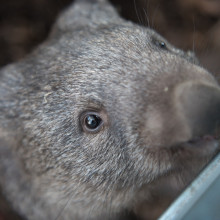Poo comes in many shapes and sizes. We're used to seeing it on the street, or accidentally stepping in different forms including logs from dogs, pellets from rabbits and pats from cows. But cube-shaped poo? Tamsin Bell asked Dr Louise Gentle from Nottingham Trent University to help us out with this stinker...
In this episode

00:00 - Why do wombats Have cube-shaped poo?
Why do wombats Have cube-shaped poo?
Tamsin Bell asked Dr Louise Gentle from Nottingham Trent University to help us out with this stinker…
Louise - The wombat is unique in the animal kingdom because it produces cube shaped poo and lots of it - around 80 to 100 cubes per night. Now the wombat is a nocturnal animal with poor eyesight, but an excellent sense of smell. It is highly territorial, so uses its cube shaped poo to mark its territory and prevent conflict.
Wombats deposit poo outside their burrows and on top of rocks and logs where they’re more easily found by other wombats. So, wombats use poo as their main way of telling who lives where, if there are any other unknown wombats in the area, and also as a way of increasing its reproductive success.
Tamsin - So now we have an idea of why wombats produce a lot of cubic poo, but how is it actually produced?
Louise - Well, wombat poo is cubic. Not because the wombat has a square shaped anus, but because it has a very long and slow digestive process. Typically two to three weeks, which makes the digestive matter extremely compacted and dry.
Tamsin - Woah! Two to three weeks. They must feel bloated all the time. Wombats have the driest poos compared to other mammals or marsupials, and these poos contain really really fine grass particles, the main part of their diet.
Louise - The first part of their long digestive tract contains ridges that mold the faeces into cubes; whereas the last part of the intestine is relatively smooth allowing the cubic shape to be maintained. The ridges in the digestive tract may cause weaknesses in the poo which make it susceptible to breaking into smaller cubes. The highly compacted nature of the poo means that the anus is unable to contour it into the usual tubular shapes, so it stays in the shape of the cubes that were formed at the start.
Basically, the wombat produces hard cubic poo as a result of its diet and long digestion. Most poo is moist so sticks where it is deposited, but the distinctive cube shape is thought to be advantageous to the wombat as it stops the hard dry poo from rolling away down the steep mountains that the wombat inhabits.
Tamsin - Wow! That is a very clever adaptation. Thank you Louise for pooting the lid on that one.
Next time, we’re considering this time travelling question from Stuart:
If you could bring a baby from the past to grow up in the present, how far back could you go before people would notice that this was a time travelling baby?










Comments
Add a comment